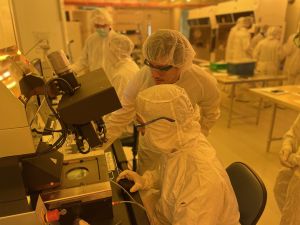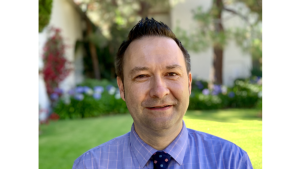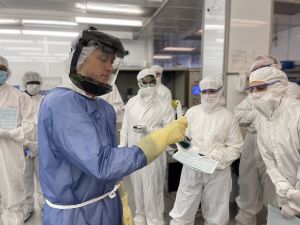Santa Barbara City College’s (SBCC) development of a micro- and nanotechnology training boot camp, has benefited from

- the National Science Foundation’s decades of investment in curriculum and faculty professional development, particularly at the Support Center for Microsystems Education ( SCME);
- expansion of its longstanding partnerships with the University of California, Santa Barbara (UCSB) to access cleanroom facilities; and
- new affiliations with companies that are seeking technicians with cleanroom experiences.
“The building of the relationships—of the connections with industry—that would not have happened if we didn't have that existing connection to UCSB ... having worked with them for a long time and then getting that connection to the NanoFab, which is the location where the industry partners come,” Jens-Uwe Kuhn explained in an interview. He noted that many of the 45 high-tech companies in SBCC’s service area with employees working at the micro- and nanoscale rent space at times in UCSB’s facilities, which were built with support from the National Science Foundation (NSF) and other entities.
Kuhn is the dean of Math and Sciences at SBCC and principal investigator of the Central Coast Partnership for Regional Industry Focused Micro/Nanotechnology Education (CC-PRIME), an Advanced Technological Education (ATE) project funded by NSF.
In the Journal of Advanced Technological Education article “Building a Micro/Nanotechnology Cleanroom Training,” Kuhn and Demis D. John, process scientist manager at UCSB, report on SBCC’s development of training for semiconductor manufacturing technicians without the community college having its own cleanroom. It is a challenge other colleges face because of the cost of building and running such facilities. CC-PRIME is also featured in ATE Impacts 2024-2025.
Learning from SCME
During an interview for this ATE Impacts Blog post and in the J ATE article, Kuhn described the lessons that the team learned from the Support Center for Microsystems Education (SCME), an ATE center at the University of New Mexico, as critical to CC-PRIME’s efforts.
When the CC-PRIME team was preparing its grant proposal, Matthias Pleil, SCME’s principal investigator, shared the curriculum SCME had been developing for more than a decade. The team also received information from the Nanotechnology Applications and Career Knowledge Network (NACK) at Penn State University and the Micro Nano Technology Education Center (MNT-EC) at Pasadena City College. SCME, NACK, and MNT-EC are ATE centers funded by NSF to support the development of the skilled technical workforce.
After SBCC received its ATE grant in 2021, Kuhn, John, and Rachel Schoeppner attended SCME’s boot camp. Schoeppner is a specialist lab manager at UCSB’s Quantum Structures Facility and Confocal Microscope and Spectroscopy Facility.

Kuhn said the week of hands-on lessons in the university cleanroom that SCME uses enhanced their “between the lines” understanding of the curriculum. As they worked through the tasks of etching silicon wafers and producing pressure sensors, Pleil told them why he taught in a particular order and gave them tips for moving students wearing personal protective equipment in small groups through the cleanroom to maximize their learning.
“There's a lot of stuff that comes across that you don't really get when you’re just looking at the curriculum. And so we found that really valuable in terms of really figuring out, ‘OK so he's doing that piece just kind of as a gap-filler, and if we want to get rid of that, that's maybe not that big of a deal, but he's doing this and putting really a lot of emphasis on this and ... he's found over the last decade that it's really, really important to do that.’ So we should probably not drop that,” Kuhn said of the team’s adaptation of SCME’s curriculum.
The team then reached out to the companies that use UCSB’s Nanofabrication Facility. At the outset seven companies provided representatives for CC-PRIME’s industry advisory board that offered input on the curriculum; twelve are now actively involved in the project.
Sharing Data on Boot Camp Outcomes
CC-PRIME has run three, 40-hour nanotech boot camps in the cleanroom at UCSB’s Quantum Structures Facility. A fourth boot camp scheduled for August has a waiting list.
Kuhn shared the following data on the status of participants from the first two cohorts:
- Four participants were community college faculty members who continue to teach in their respective fields.
- Six participants were community college students who are still enrolled and progressing in science, technology, engineering, or math degree programs.
- Ten participants were employed and “up-skilling.” The two who were in non-technical fields acquired semiconductor technician jobs after the training. The eight others were in technical fields. Seven are still employed in their respective fields; one has switched jobs. The project’s evaluator is trying to find out whether that person is in a technical or non-technical field, and is gathering data on the third cohort.
Building the Pathway & Raising Awareness

All the partner companies would like CC-PRIME to teach more micro and nanotech skills. (Prior to the grant the college offered just a general education course on nanotechnology and society.) But given the challenges of scheduling more boot camps in the highly in-demand cleanrooms, the team is considering what equipment it can use for lessons in regular campus facilities and how to incorporate the tools available from NACK’s Remotely Accessible Instruments for Nanotechnology Network.
Employers have also suggested broadening the curriculum to prepare maintenance technicians, and individuals who can do testing and packaging.
“These are all things we’re looking at building into a more robust pathway,” Kuhn said. In an email after the interview, he explained that having a full program in the future with multiple courses over several semesters with multiple on-ramps and off-ramps will depend on funding.
Developing that pathway carries with it the imperative to raise awareness of micro- and nanotech careers among the region’s residents. Kuhn said the high cost of living in Central California means it is difficult for companies to recruit technicians from other locations. Despite the presence of 45 companies—some with 500+ employees—utilizing micro- and nanotech equipment in their operations the technology and its opportunities are not obvious to many residents.
“So what we're trying to get out of this is really building a local workforce pipeline, right, that's broad enough to serve these industry partners, and ultimately gets the students these jobs locally,” Kuhn said, adding that student recruitment will happen eventually.
“We're still working on, one, building out the pathway, right, and, two, working on that awareness piece.”
 Subscribe
Subscribe


 See More ATE Impacts
See More ATE Impacts
Comments
There are no comments yet for this entry. Please Log In to post one.